Heat Loss in a Poorly Insulated House
Surveyor's reports and surveys are not all the same
1stAssociated.com surveyors have great interest or possibly better to say intrigue in the way that we are moving with regard to improving energy efficiency of properties. There have been all sorts of different types of progress in this market over the years and with energy efficiency reports being carried out on properties and various government initiatives to get us to save energy we are getting to the point where the energy efficiency of a building is changing the way it is constructed more than it has ever done in the history of house building and commercial property building.
Plain English survey reports
This article we have written is to stimulate interest in this area. We have also written it to show how we use lots of sketches and photos in a report. The feedback has shown time and time again that our clients really like having the sketches and photos as well as our plain English reports. Along with being independent surveyors we call these our unique selling points but they really shouldn't be unique, all surveyors should offer such a service.
Surveyors will meet you at the survey
We would add that we would always recommend that you meet your independent surveyor at the property as it is best that the surveyor gets to understand your needs and requirements first hand. Most surveyors are happy to walk you around and you can even give the surveyor a helping hand during the course of the survey! Please feel free to phone us on 0800 298 5424 for a friendly chat.
Insulation – at one time there was no insulation
Up until the mid 1940s we did not really consider insulation in properties, for example it was only in the 1960s that we started putting insulation in roofs and then it was about 50mm, in the 1970s this was upgraded to 100mm. Then we started to think about double glazing and cavity wall insulation. Since then insulation standards have increased considerably and today we are looking at typically using insulation not only in the roof but also in the walls, floors and windows.

Percentage heat loss through a property
Roof Insulation
As you can see from the above sketch on heat loss it shows that:
25% of heat loss can be lost through your roof
35% through the walls
25% through the windows
15% through the floors
It is very important then to insulate the roof as most people know that heat rises. Current Building Regulations require roofs to be insulated, we did use the term heavily insulated originally but who knows how thick the insulation will get in years to come. We typically see roofs in older properties insulated from nothing (although we don't see many of these) to more typically 100mm - 200mm of fibreglass insulation. Interestingly in roofs we often find rolls of insulation have literally been thrown in the roof and never used. Whilst we know that your roof is not the most interesting place and normally used for storage of Christmas decorations and suchlike, the occasional look in the roof is well worthwhile, if not for roof leaks, at least once you have had your insulation carried out to check that all your insulation has actually been laid.

Fibreglass insulation all over the
place does indicate there has been a
leak in the roof and there has been
someone up there investigating
where the leak is coming from
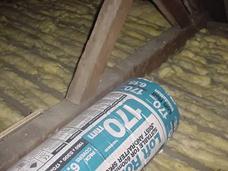
Bag of insulation that was never used
and left in the roof
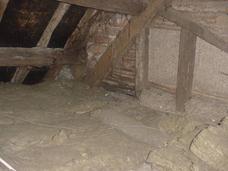
Deep fibreglass insulation covering
the joists and the electric system
makes surveying difficult
Roof Insulation in loft conversions
Our surveyors have found when carrying out surveys that loft conversions are not adequately insulated and therefore can suffer from solar gain in the summer months and heat loss in the colder months. This can, in extreme circumstances make the rooms unbearable to live in.
Insulation to the pitch of the roof within loft conversions wasn't the first time that we have seen this sort of insulation as some older roofs also had polystyrene pushed between the common rafters (the ones that form the pitch of the roof). This, whilst having reasonable thermal properties, doesn't have anything like the thermal properties of an insulation board made by Kingspan or Celotex for example which is commonly known as rigid insulation foam.

Insulation being added to the pitch
of a roof
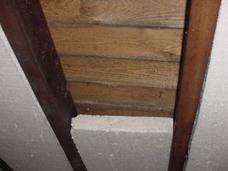
Insulation to close boarded roof
Insulating flat roofs
Where do we start with flat roofs? We literally could write a book on flat roofs. We will start with the different types, broadly flat roofs fall into two categories:
1) a cold roof
2) a modern warm roof

Sketch shows twenty five percent
of heat is lost through flat roof
Substantial improvements have been made to flat roofs and we have even used it ourselves to add insulation to a flat roof. As you can see in the photograph and sketch insulation can now be put into flat roofs to improve their energy efficiency, this is known as a warm roof. A cold roof is one without insulation or with insulation between the ceiling joists.

Warm Deck flat roof

Example of insulation added to flat roof
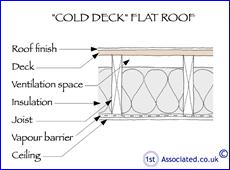
Example of insulation added to flat roof
Wall insulation
We make no apologies for another sketch; we find that a sketch is really worth a thousand words. Here is a different way of viewing heat loss, the sketch shows a cross section of a building. What always surprises everyone is that thirty five percent of heat can be lost through the walls. During a building survey we would assess whether cavity wall insulation is present or if insulation panels have been used or indeed if any insulation has been used. Cavity wall insulation has been very popular in recent years as a way of improving thermal efficiency of older buildings however it has been built into newer properties for many years, although it has taken different forms over the years
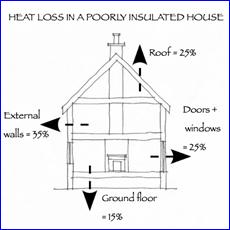
Percentage heat loss through a
property
Adding in wall insulation at a later date
There are a number of potential problems associated with cavity wall insulation which is added at a later date which can lead to problems with the wall ties rusting due to the way that the insulation allows dampness to bridge the gap. From what we understand, most of these original problems have now been eliminated but the one problem that remains is that insulation added in a cavity at a later date is not held in place and it does over the years settle and sink.
When you purchase a property we would always recommend that your Legal Advisor checks and confirms if insulation was added when the property was originally built or if it has been added at a later date. A surveyor will often be able to see if insulation has been added by looking for the holes that are drilled in the walls to pump in the insulation.
Double glazing reduces heat loss
Just as a reminder:
25% of heat loss can be lost through your roof
35% through the walls
25% through the windows
15% through the floors
The heat loss from windows and doors is 25%. The installation of double glazed windows and doors does reduce heat loss from your property. However we would argue that the benefits of double glazing have been oversold by the double glazing industry. It is an industry which is often portrayed as having very strong methods of selling. We personally haven't experienced this and we have dealt with a number of double glazing companies over the years and have had double glazing installed.
One thing you may not be aware of is where there is a mixture of double glazed and single glazed windows we have found condensation is drawn to the single glazed windows. We recently came across a very expensive refurbishment which had double glazed the front windows but the rear windows were single glazed and had condensation on.
Insulation to floors
Just as a reminder yet again:
25% of heat can be lost through the roof
35% through the walls
25% through the windows
15% through the floors

As heat rises there is a relatively low percentage of heat that goes through the floor. We would also say that insulation to floors is a relatively new additional requirement for Building Regulations since around 1994 (we would just add that new in surveying terms can mean in the last one hundred years!). We have personally lived in a property where some of the floors had been insulated and some hadn't. In all honesty we couldn't tell the difference. The reason some floors were insulated and some were not is because we added a modern extension to the house.
Theory of insulated floors
We understand the theory and again as you can see in the sketch of percentage heat loss there is fifteen percent heat going out through the floors so it is important that this area is insulated too. It is relatively easily carried out as long as it is insulated when it is being built.
We have seen systems which can be fitted to suspended timber floors. This is where insulation is put between the floor joists. We haven't experienced it, i.e. personally lived in it, we have however experienced living in a suspended timber floored house which didn't have insulation and the wind did really blow through and under the floor during the winter months which we certainly noticed. Most people resolve this by putting hardboard on the floor and then a deep underlayer and a deep carpet, however this in turn means that the floor cannot breathe as much as it should do.
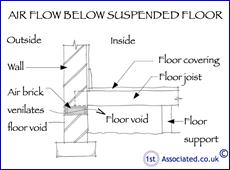
Thermal imaging
Surveyors can carry out thermal imaging for you which will identify any heat loss areas that your property has providing they are trained in using thermal imaging cameras. Thermal imaging cameras have changed considerably over the years, the technology has improved and the price has come down slightly. We can carry out thermal imaging of your property if you so wish. The climate does have to be managed and controlled for best results. As you can see from the thermal images below it is useful in many situations.

Internal wall front bedroom showing constant
heat transfer levels on a wall that lacks
insulation in the test holes
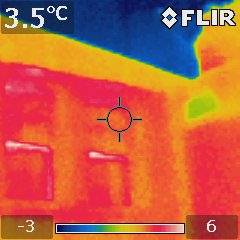
Concrete frame building with heat loss through
he entirety of the wall panel

Concrete frame building with heat loss through
the entirety of the wall panel
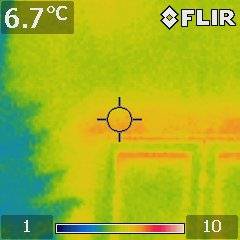
Close up view of window (blue to the side is the
bush). Heat loss is occurring to the top joint of
the window and also through the lintel that is
above the window.
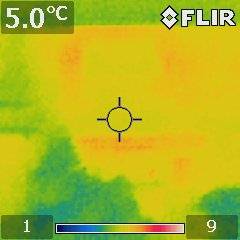
Window – the red marks indicate that it is losing
heat around the edges

Heat loss is occurring to the sides of the window
as well as to the top and via the lintel .
Other articles on the 1stAssociated.com website
We would remind you that we have carried out many articles on the 1stAssociated website, we hope you found this article interesting so far. On the heat loss and insulation point of view we have written the following articles we would recommend you read:
Insulation, Damp Propf Courses and Energy Performances Certificates
Energy Efficiency, Have we got it all wrong?
Why you have never seen any building surveys or structural surveys like ours
Rising damp, condensation and damp through your walls
Spray foam insulation within roofs, Does it work?
Borescope or Endoscope used to look inside walls
We have over the years used Borescopes or Endoscopes, whichever you wish to call them, to inspect within cavity walls to see if any insulation is present. Interestingly, in the sketch shown the insulation had sunk down approximately 1 metre over the years so there was no insulation at the top of the property. We have spoken to various other surveyors on this matter and some say that they think insulation can settle to almost half its original. We have over the years gone off using endoscopes or borescopes as we find the pictures are relatively restricted even with a camera endoscope like the one below which takes videos. We much prefer, if at all possible, to remove a brick to get a better view.

Borescope inspection through pre-
drilled holes.

Borescope inspection through pre-
drilled holes.
With ventilation and insulation a balance is needed
Finally, we would mention that care should be taken that properties are not insulated disproportionately to the ventilation as this can cause condensation; you need to ventilate any property that is insulated.
We would strongly recommend that any condensation is removed as quickly as possible, we like humidity controlled extract fans as they remember to not only switch themselves on but also off once the humidity has been removed.

Dampness and mould to the
roof timbers on poorly
ventilated roof
What can a Surveyor do for you?
Building surveyors are experts in looking at building problems and can analyse a building and advise how best to carry out energy efficiency for that era of building. What's more, the building surveyor should be able to do it as part of a building survey or structural survey when you buy the house so you have the information from day one.
Independent Surveyors
If you truly do want an independent expert opinion from a building surveyor we are happy to do valuations, building surveys, structural surveys, structural reports, engineers reports, specific defects reports, home buyers reports or any other property matters. Please contact us on 0 800 298 5424 to have a free of charge friendly chat with one of our surveyors.
We feel our surveys are quite unique, as they are written to your level of knowledge. The surveys include photos and sketches and definitions. The survey will also include an action required section and an estimate of costs in the executive summary. We are more than happy to meet you at the property whilst carrying out the survey to discuss any specific issues you may have or have a general chat about what we have found at the end of the survey.
Commercial Property
If you are looking for commercial property, whether it is freehold or leasehold, we would recommend a survey as this will prevent dilapidations claims in the long run. You may wish to look at our Dilapidations Website at www.DilapsHelp.com and for Disputes go to our Disputes Help site www.DisputesHelp.com , both of which we have been advised are very helpful!
We hope you found the article of use and if you have any experiences that you feel should be added to this article that would benefit others, or you feel that some of the information that we have put is wrong then please do not hesitate to contact us (we are only human).
The contents of the website are for general information only and is not intended to be relied upon for specific or general decisions. Appropriate independent professional advice should be paid for before making such a decision.
All rights are reserved the contents of the website are not to be reproduced or transmitted in any form in whole or part without the express written permission of www.1stAssociated.com
